Part Three
Hurricane Comin . . . the end is in sight, but the story is not over, yet.
Story and Photos by David H. Lyman
This is Part Three of “Hurricane Comin” originally published ion Caribbean Compass, July 2020
Monday, September 18th, 1989
By 6:00am it’s light enough to see. The wind is still howling, but I can now stand up on the deck and look around the harbor. I creep back to the cabin and get my camera to record what I can of what’s left. There had been 55 boats anchored in Coral Harbor when Hurricane Hugo came rampaging through last night. All I count now are five of us still riding to our anchors. Derek’s ketch is still there.
I sit on the rolled up dinghy and study the situation. There are boats stacked up on the beach road, two and three deep, their mooring lines chafed through, hanging limp off their bows. The chains of others lead back out into the water to where their anchors have dragged. Boats are ten feet inland from the water’s edge, lifted there by surge, wind and waves. Others are piled on top of each other in the mangroves. Some smaller boats are crushed, a total loss, others only scraped. A crane will come in a few weeks, pick some of them up and drop them back in deep water, and away they’ll go under their own power to be hauled, repaired and painted. Others, those beyond repair, will be loaded on a barge and dumped in deep water far off shore.
I look at my anchor lines. The snubbing line on the anchor chain parted sometime in the night. It hangs over the bow roller, the chafe hose missing. The abandoned sloop next to me is still riding to her anchor line. Her jib, which had been wound tightly around its furling headstay, came loose in the night and is now in shreds, what’s left of it.
One look at the anemometer, now frozen at 90 knots, reminds me that lightning struck my mast head last night.
Below, out of wind, it’s cozy and quiet. A relief. One tap on the barometer glass and the needle jumps up the dial; the eye of the storm passed sometime in the early morning, I knew that when the wind shifted at around four o’clock, it placed Coral Harbor on the back side of the hurricane. The worst is over. The wind is now south- west. We are in the lee of the hills of St. John. I shed my jacket and look in the mirror in the head. There’s a red ring around my face from wearing the dive mask all night. I shower off the salt and sweat, towel off, brush my teeth, pull on a T-shirt and took my camera into the cockpit to document what is left of the mess.
By 9:00 it is all over, the harbor is quiet, calm. Twelve hours have passed.
I’m exhausted, yet full of nervous energy and adrenaline. I eat breakfast, then begin the process of getting the boat back into sailing condition.
After Hurricane Hugo
Getting the anchors up took more than an hour. They were buried so deep in the sand I had to work them out, by motoring forward then in reverse.
It took the rest of the morning to clean and stow the ground tackle, blow up the dinghy and get it back in the water. It was slow work: I was still in a daze, still processing the experience, shaking off the effects of the adrenalin and lack of sleep. All around me was destruction.
Curiosity got the better of me. I wanted to see what Hugo had left in his wake. I grabbed my cam- era bag, jumped into the dinghy and took a slow cruise around the harbor, photographing the devastation. It was sad to see all those fine yachts beached, on their sides, crews milling about. The dinghy took me over to Hurricane Hole, where the damage was worse.
Boats on top of each other, a few sunk with only masts visible above the water, hulls smashed, masts toppled. Crews in shock. Men in tears, their floating homes destroyed. I felt guilty at having come through with only a blown out VHF antenna. An old wooden motorsailer, smashed into a dozen pieces, was washed up on the coral shore. Crews were helping each other sort out the mess, untangling rigs, retrieving ground tackle. Hardly anyone came through untouched.
The devastation is beyond my ability to describe. My photographs tell a more compelling story.
On my way back to Afaran, Derek hailed me.
“We’re going to Cruz Bay to get the boatyard cleaned up and the charter boats back on their moorings. You need anything?”
“Can I join you?” I shouted back.
“Sure. Tie up here. We’ll go ashore in my dink. There’s not much left of the
dinghy dock.”
The drive to Cruz Bay was saddening. This beautiful, lush green island was a wreck. Most of the leaves on the trees had been blown off, littering the road. The island looked like Maine in November, the trees skeleton-bare against the sky.
Limbs, whole trees littered the road. The sound of chain saws filled the air as we drove over the top of the island.
In Cruz Bay, the village looked like a war zone. Roofs missing, windows blown in. Trash and parts of buildings covered the streets. People walked around in a daze. Above Caribbean Connections, a two-by-four had been driven through a sheet of three-quarter-inch of plywood covering an office window. Electricity was off and would be for two weeks. There was no phone service.
The crew from the yard, Derek and I retrieved anchors, coiled rodes, and put the sleek Hinkley yachts back on their moorings in Great Cruz Bay. The fleet came through with no damage. The eye of Hugo had passed south of St. John. The north side of the island was in the lee. The fleet had been protected from the worst of the winds by the island itself.
Knowing the path of a hurricane’s eye, the center of low pressure, is imperative, but that is often not known until it is too late. My next two hurricanes would prove that.
The maritime author and guru Don Street suggests running south to Grenada or Trinidad for hurricane season. I’d heed his advice now.
A few days later I got underway and motored over to West End on Tortola to call home. I wanted to let my family, friends and staff know I and the boat were okay. Tortola had no power or phone service either. I motored around Sopers Hole photo- graphing the wreckage, but did not land. I sailed over to Jost Van Dyke to see Foxy and Tess, who came through fine. Then over to Red Hook, St. Thomas, where wreck- age lined the shore and blue tarps covered 90 percent of the roofs.
Mine was the only boat on the water. It felt as if I’d just woken up to find I was the last man left in the world. There were no ferry boats, no commercial craft, no other yachts on the water, just Afaran.
I sailed around to Charlotte Amalie, St. Thomas’s major harbor. The five story hotel on Frenchman’s Reef at the entrance of the harbor was wiped out. The wind had blown out the walls, windows, the interior partitions as well as all the furniture, on every floor. All that was left were the concrete floors and the plumbing. You could see completely through the structure.
At Bobby’s Marina, near Sub Base, boats were piled five and six deep, smashed and sunk. I saw a 30-foot catamaran lodged on the second floor balcony of a condo on Hassel Island.
No cruise ships, no yachts left in the two anchorages. No traffic on the streets. The only sound from shore was the buzz of chain saws.
The Virgin Islands were a wreck. I turned around and motored back to St. John and anchored in Caneel Bay, and waited. There was little I could do. I couldn’t get out. There was no inter-island ferry service and the airport would be closed for a month to commercial traffic. I wrote about the experience, worked on the boat, read and listened to the radio.
St. Croix had been devastated. Anarchy was the rule. Theft was rampant. The larger resorts, with wealthy guests, were prime targets. Their managers flew armed mercenaries in by helicopter to provide protection from the mobs ransacking the island. Even the National Guard was of no help; in fact, images from a heli- copter showed military trucks loading contraband from the mall stores. A car rental company put out the word that the stolen tires would fit only their rental cars and if the tires were returned, no questions would be asked.
Two weeks after Hurricane Hugo phone service was available, but only in Charlotte Amalie. I sailed over, anchored, went ashore and called home, then checked on flights. It would be a few days before normal service between Puerto Rico and the States would resume. If I could get to Puerto Rico I’d have to stand in line. Getting from St. Thomas to Puerto Rico was the problem. There were no commercial flights, but I heard rumors that small private planes were ferrying people over to PR.
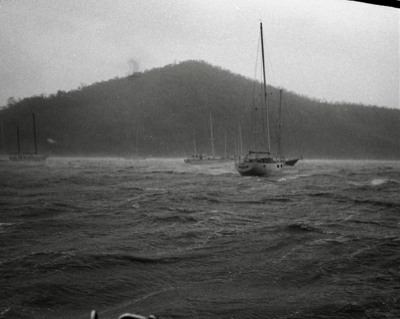
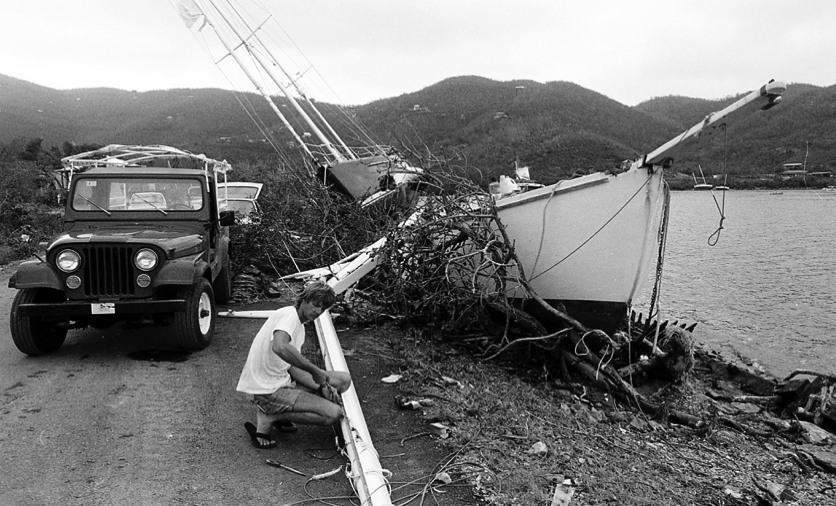
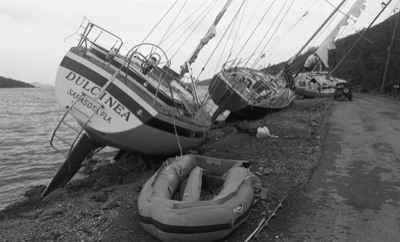
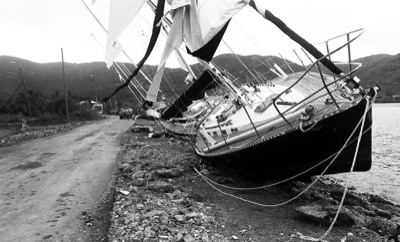
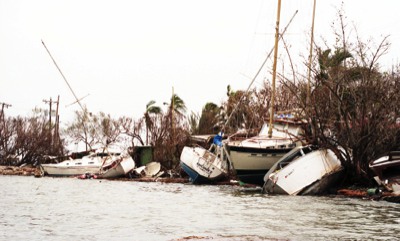
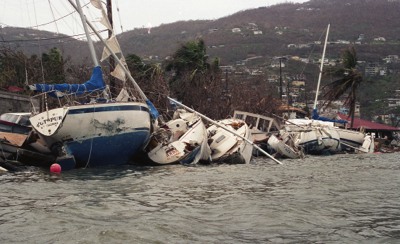

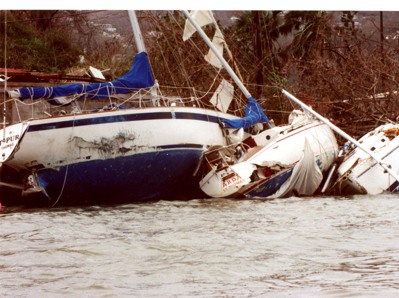
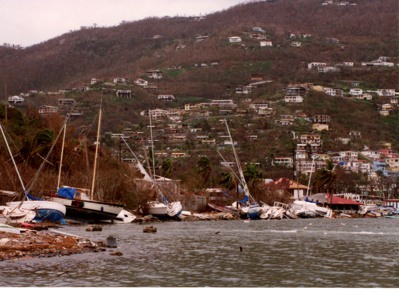
Heading Home to Maine
I put Afaran back on her mooring in Great Cruz Bay, packed up, and took the dinghy around to the ferry terminal in Cruz Bay. Derek and his team would retrieve my dinghy and stow it until I returned later that fall. I took one of the first ferries to Red Hook, then a taxi to the airport, the driver sharing stories with me of what his family and friends experienced during Hugo. Men with chain saws were clearing away the trees and brush that lit- tered the road. Homes had been blown off their foundations.The World War II hangar that served as St. Thomas’s airport terminal was destroyed. The walls and roof had been blown away, and all that was left of the old Banana Republic terminal was the steel frame. I’ll miss the old one. You knew you were arriving in the tropics when you deplaned and walked to the old hangar to retrieve your bags. A new terminal, only half built, would not be serviceable for months.
Rumors that private planes were ferrying people to the airport at San Juan proved true, for a price. I stood in line on the edge of the runway. Someone asked me if they could be put on the list. I was wearing my white captain’s shirt with epaulets, and must have appeared semi-official. I took out my notebook, and began to organize a passenger list.
A small six-seater twin engine Piper Comanche landed and taxied over to where our group was forming. The pilot got out and walked over to me. He was from an evangelical church organization in the States, there to help, but for a price. They would take whatever anyone wanted to donate, but the going rate was US$100, cash.
I loaded up the plane, waved goodbye and turned to add more people to the list. Around three in the afternoon, I put myself on the list, handed the list to an official- looking chap behind me, and climbed in next to the pilot. I was off, on my way back to Maine.
Behind me, the islands slowly began to recover.
I’d live through two more hurricanes, but Hurricane Hugo would remain a defining event in my life and the lives of most Virgin Islanders. Over the next 20 years, Hugo would be followed through Hurricane Alley by Hurricane Luis (1995) and a week later by Marilyn, then Jeanne (2004), and Irma (2017) followed by Maria two weeks later.
This coming season may add other names.
David Lyman, a marine writer, lives in Maine and can often be found on a boat somewhere in the Caribbean in the winter. His memoir of the 14 months he spent as a Navy photojournalist with a Seabee construction battalion in Vietnam in 1967 is available at www.Seabee71.com